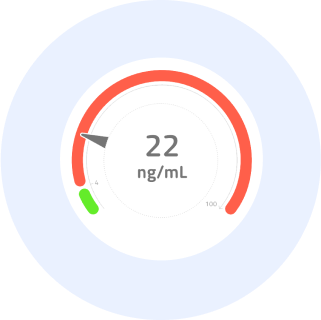Warum soll ich den PSA-Wert testen?
Egal ob Entzündung, gutartige Vergrößerung oder Krebserkrankung – Erkrankungen der Prostata können Sie umso besser behandeln, je früher sie erkannt werden.
So kann eine Prostatitis (Prostataentzündung) bei spätem Eingreifen chronisch werden, mit möglichen Folgen wie Problemen beim Wasserlassen und Erektionsstörungen. Prostatakrebs kann tödlich sein. DE: In Deutschland ist er die häufigste Krebsart bei Männern, jedes Jahr werden mehr als 60.000 Neuerkrankungen erfasst.
Gleichzeitig zeigen sich manche Veränderungen der Prostata (wie Prostatakrebs) häufig lange Zeit nicht durch Symptome. Der PSA-Test kann dabei helfen, frühzeitig einen Hinweis auf die Krankheiten zu erhalten, was die Behandlungschancen verbessern kann.
Wichtig ist, dass Sie sich bei einem erhöhten PSA-Wert ärztlich untersuchen lassen. Denn in vielen Fällen ist der PSA-Wert erhöht, ohne dass eine Krebserkrankung vorliegt. Ärzt*innen können dem genauer nachgehen und Ihnen, je nach Diagnose, individuelle Empfehlungen für die Therapie geben.
Wer sollte den Test machen?
Der cerascreen® PSA Test ist für Männer sinnvoll, beziehungsweise für Menschen, die eine Prostata haben.
In der Regel werden Untersuchungen zur Früherkennung von Prostatakrebs für Männer ab dem 45. Lebensjahr empfohlen, da der Krebs meist im höheren Alter auftritt. Andere Erkrankungen der Prostata, wie die Prostataentzündung, können allerdings Menschen aller Altersgruppen gleichermaßen betreffen.
Besonders sinnvoll ist ein PSA-Test, wenn Sie bei sich ein erhöhtes Risiko für Prostatakrebs vermuten – zum Beispiel, weil in Ihrer Familie bereits Fälle vorgekommen sind.
Wie funktioniert der Test?
Für den PSA Test entnehmen Sie sich mit einer Lanzette eine kleine Blutprobe aus Ihrer Fingerspitze. Dafür sind nur wenige Tropfen Blut nötig. Die Tropfen geben Sie auf eine Trockenblutkarte – so müssen Sie wirklich nur sehr wenig Blut entnehmen und die Probe ist lange haltbar.
Die Probe wird per Rücksendeumschlag kostenfrei an ein medizinisches Fachlabor geschickt. Das Labor analysiert, wie hoch die Konzentration des prostataspezifischen Antigens in Ihrem Blut ist.
Nach der Auswertung bekommen Sie eine Benachrichtigung und können über den Online-Kundenbereich oder die mein cerascreen® App auf den Ergebnisbericht zugreifen.
Tipp: In den 24 Stunden vor der Probenentnahme sollten Sie möglichst keine Dinge tun, die den PSA-Wert erhöhen können. Dazu gehören Sex und generell ein Samenerguss, körperliche Anstrengung und vor allem auch Situationen, die Druck auf die Prostata ausüben, wie Fahrradfahren. Auch eine anhaltende Verstopfung kann zu höheren PSA-Werten führen.
Was sagt mir der Ergebnisbericht?
Der Ergebnisbericht des Tests verrät Ihnen die Konzentration des prostataspezifischen Antigens (PSA) in Ihrem Blut.
Sie erfahren außerdem ob Ihr Ergebnis im Referenzbereich liegt, also im Rahmen der üblichen Werte, die bei gesunden Erwachsenen festgestellt werden. Liegt der PSA-Wert über 4 Nanogramm pro Milliliter Blut, befindet er sich nach diesen Referenzwerten im erhöhten Bereich.
Das Ergebnis ist für sich keine eindeutige Krankheitsdiagnose, da ein erhöhter PSA-Wert auf verschiedene Ursachen zurückgehen kann und manchmal auch gar keinen Krankheitswert hat.
Welche Empfehlungen bekomme ich?
Sollten sich Ihr PSA-Wert im erhöhten Bereich bewegen, empfehlen wir Ihnen, Ihre Ärztin oder Ihren Arzt für weitere Untersuchungen zu kontaktieren.
Außerdem geben wir Ihnen eine Reihe von Empfehlungen, mit denen Sie Risikofaktoren für Prostatakrebs vermeiden und Prostataerkrankungen vorbeugen können. Dabei geht es in erster Linie um einen gesunden Lebensstil mit ausgewogener Ernährung und regelmäßiger Bewegung.
Was ist das PSA?
Das prostataspezifische Antigen (PSA) ist ein Protein, das in der Prostata von gesunden Zellen produziert wird. Je größer die Prostata, desto mehr PSA entsteht – deshalb erhöhen sich die Werte auch in der Regel im Alter, wo sich die Prostata natürlicherweise vergrößert.
Doch auch Krankheiten können dazu führen, dass die Prostata wächst und mehr PSA abgibt. Das ist bei einer gutartigen Prostatavergrößerung der Fall, aber auch wenn bei Prostatakrebs Krebszellen entstehen.
Je mehr PSA in der Prostata entsteht, desto mehr lässt sich auch im Blut nachweisen – darauf basieren die PSA-Bluttests.
Was ist eine Prostatitis?
Die Prostatitis (Prostataentzündung) entsteht in der Regel durch eine bakterielle Infektion, bei der die Erreger aus dem Blut, der Blase oder der Harnröhre in die Prostata wandern.
Die Prostataentzündung kann verschiedenen unangenehme Symptome verursachen, vor allem:
- Schmerzen im Dammbereich
- Fieber
- Schwierigkeiten und Schmerzen beim Wasserlassen
- Erektionsstörungen
- Müdigkeit und Schwächegefühl
Wenn die Krankheit drei Monate oder länger anhält, sprechen Fachleute von einer chronischen Prostatitis. Dabei treten die Beschwerden meistens nicht so stark auf wie bei einer akuten Prostataentzündung.
Was ist eine gutartige Prostatavergrößerung?
Wenn sich nicht-bösartige Zellen in der der Prostata vermehren und sie wachsen lassen, spricht man von einem benignen Prostatasyndrom (BPS) oder einer gutartigen Prostatavergrößerung. Diese Veränderung der Prostata kommt im höheren Alter sehr häufig vor.
Aus den gutartigen Zellveränderungen entsteht in der Regel kein Prostatakrebs. Es kann durch die vergrößerte Prostata trotzdem zu Beschwerden kommen, zum Beispiel zu häufigem Harndrang, Schmerzen beim Wasserlassen und Inkontinenz.
Was passiert bei Prostatakrebs?
Prostatakrebs gehört zu den am weitesten verbreiteten Krebserkrankungen überhaupt. Weltweit ist er der zweithäufigste Krebs bei Männern und die fünfthäufigste Todesursache*.
Der wichtigste Risikofaktor für Prostatakrebs ist das Alter. Bei unter 50-Jährigen ist die Krebserkrankung sehr selten, im hohen Alter steigt das Risiko dann aber stark an. Vermutlich entwickeln sehr alte Männer fast immer einen Prostatakrebs: Studien, in denen Menschen nach Ihrem Tod in einer Autopsie untersucht wurden, zeigten diese Art von Tumor bei neun von zehn Männern über 90.
Zwar können manche Tumore in der Prostata schnell wachsen und zu gefährlichen Metastasen führen. Häufig wächst der Prostatakrebs aber nur langsam oder für lange Zeit gar nicht. Solange der Krebs auf die Prostata begrenzt bleibt, verursacht er meist kaum Beschwerden. Weil der Krebs häufig so langsam wächst, sind auch die Zahlen der Todesfälle durch Prostatakrebs relativ niedrig, obwohl die Krankheit so häufig vorkommt: Betroffene sterben häufig an anderen Ursachen – also mit dem Prostatakrebs, aber nicht am Prostatakrebs.
*Quelle: Rawla, Prashanth. “Epidemiology of Prostate Cancer.” World journal of oncology vol. 10,2 (2019): 63-89. doi:10.14740/wjon1191
Wie wird Prostatakrebs diagnostiziert und behandelt?
Zur Früherkennung von Prostatakrebs führen Fachärzt*innen für Urologie neben PSA-Tests auch Tastuntersuchungen der Prostata durch.
Diese körperlichen Untersuchungen werden in Deutschland für Männer ab 45 einmal im Jahr von der Krankenkasse bezahlt. Einen vorbeugenden PSA-Test müssen Sie selbst zahlen.
Liegt durch Untersuchungen wie PSA-Wert, Tastuntersuchung, Ultraschall und MRT ein begründeter Verdacht vor, führen Ärzt*innen in der Regel eine Biopsie durch. Dabei entnehmen sie Gewebe aus der Prostata, das dann im Labor untersucht wird. Diese Biopsie führt meist zu einer eindeutigen Diagnose.
Wird ein Tumor in der Prostata entdeckt, kann er unter anderem mit einer operativen Prostataentfernung, Strahlentherapie, Chemotherapie oder Hormontherapie behandelt werden. Befindet sich der Krebs im frühen Stadium und hat noch keine Metastasen gebildet, lässt er sich oft gut heilen. Es kann durch eine Operation allerdings zu Komplikationen und Folgeerscheinungen wie Inkontinenz und Impotenz kommen.
Was sind die Symptome von Prostatakrebs?
Prostatakrebs verursacht oft jahrelang keine Symptome. Deshalb ist er ohne Früherkennungs-Untersuchungen nur schwer zu erkennen.
Es gibt trotzdem einige mögliche Symptome, auf die Sie achten können, vor allem in Kombination mit einem erhöhten PSA-Wert. Dazu gehören unter anderem:
- Schmerzen beim Urinieren
- schwacher Urinfluss und das Gefühl einer unvollständigen Blasenentleerung
- plötzlicher Gewichtsverlust und verkürzte Ausdauer
- Schmerzen oder Schwellungen am Körper
- Blut im Stuhl oder ein lockerer Stuhl
- andauernder Husten mit unbekannter Ursache
Warum zahlt die Krankenkasse kein PSA-Screening?
Fachleute diskutieren im Moment sehr kontrovers darüber, ob regelmäßige PSA-Tests für Männer ab 45 Jahren zu einer Standard-Vorsorgeuntersuchung für Prostatakrebs werden sollen. Bislang ist strittig, ob der Nutzen der Tests größer ist als ihr potentieller psychischer und finanzieller Schaden – es laufen aber gerade einige größere Studien, die helfen sollen, die PSA-Messung neu zu bewerten.
Die Krankenkassen zahlen den Test bislang nicht, ohne dass ein begründeter Verdacht besteht. Auch wenn Sie ihn beim Arzt durchführen, müssen Sie in der Regel selbst zahlen, der PSA-Test ist eine sogenannte individuelle Gesundheitsleistung (IGeL).
Der Vorteil der PSA-Untersuchung ist, dass damit Fälle von Prostatakrebs sehr früh erkannt werden können. Und wie bei allen Krebserkrankungen gilt: Je früher sie behandelt werden, desto besser sind die Chancen auf eine Heilung. Auf der Basis einer großen europäischen Studie* schätzen Forschende, dass durch PSA-Tests 3 von 1.000 Männern davor bewahrt werden können, Metastasen zu entwickeln und an Prostatakrebs zu sterben.
Der Nachteil ist, dass der PSA-Wert erhöht sein kann, ohne dass eine Krebserkrankung vorliegt. Das führt dazu, dass manche Betroffene Untersuchungen und Behandlungen auf sich nehmen, die gar nicht nötig gewesen wären und die Komplikationen mit sich bringen können. Oft ist die potentielle Krebsdiagnose auch eine große psychische Belastung. Dazu kommt, dass Prostatakrebs häufig erst im hohen Alter auftritt – oft muss er nicht behandelt werden, weil zuvor andere Ursachen zum Tode führen. Der PSA-Test kann einen Tumor auch übersehen, da Prostatakrebs im frühen Stadium nicht immer für erhöhte PSA-Werte sorgt.
*Quelle: Schröder, Fritz H et al. “Screening and prostate cancer mortality: results of the European Randomised Study of Screening for Prostate Cancer (ERSPC) at 13 years of follow-up.” Lancet (London, England) vol. 384,9959 (2014): 2027-35. doi:10.1016/S0140-6736(14)60525-0
Für wen ist der Test nicht geeignet?
Der PSATest ist für bestimmte Personengruppen nicht oder nur eingeschränkt geeignet:
Menschen mit ansteckenden Krankheiten wie Hepatitis und HIV dürfen den PSATestnicht durchführen.
Menschen mit der Bluterkrankheit (Hämophilie) sollten den Bluttest nicht durchführen.
Der PSATesteignet sich nicht für Kinder unter 18 Jahren.
Der Test ist nicht dazu da, Krankheiten zu diagnostizieren. Leiden Sie beispielsweise unter starken Schmerzen, wenden Sie sich an Ihre Ärzt*innen.
Warum dürfen Kinder unter 18 Jahren den Test nicht durchführen?
Unsere Tests sind nicht für minderjährige Kinder und Jugendliche unter 18 Jahren geeignet. Unter 18-Jährige können die Tests nicht online aktivieren und somit auch kein Testergebnis erhalten. Wir bitten Sie darum, die Tests auch nicht an Ihren Kindern durchzuführen.
Kinder und Jugendliche brauchen eine viel engere Betreuung und Beratung, was medizinische Tests und deren Interpretation angeht. Die Testdurchführung mit Lanzetten und Chemikalien ist nicht ohne Risiko und müsste von Erziehungsberechtigten eng betreut werden. Dazu kommt, dass die Referenzwerte, die wir für die Messwerte angegeben, immer auf Daten von Erwachsenen beruhen. Bei Kindern wäre das Risiko sehr hoch, dass die Ergebnisse falsch interpretiert werden.
Wir wollen unserer Verantwortung als Anbieter von Medizinprodukten nachkommen und sichergehen, dass Kinder und Jugendliche nicht durch für sie schwer interpretierbare Messergebnisse verunsichert werden. Da wir nicht kontrollieren können, ob die Erziehungsberechtigten der Minderjährigen tatsächlich der Testdurchführung zustimmen und sie beaufsichtigen, schließen wir die Tests für unter 18-Jährige ganz aus.
Wenn Sie unter 18 sind und einen Test gekauft haben, wenden Sie sich bitte an unseren Kundensupport.














